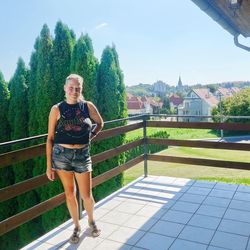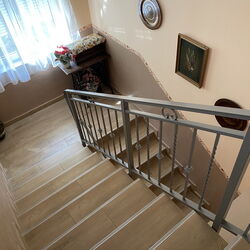The kingdom of aged cheese
Just a few kilometers from Hévíz, in the tranquil village of Nemesbük, Jersey cows graze peacefully on lush pastures. From their rich, creamy milk, András Korosa creates something truly special.
At this small family farm, aged cheeses are crafted with simple ingredients, homegrown herbs, and — above all — time and care, resulting in flavors that bring people back again and again.
From curiosity to craft
Fifteen years ago, András moved to Nemesbük. What started with poultry expanded to Racka sheep, and eventually led to his greatest passion: Jersey cows. Cheesemaking wasn’t a family tradition — as András says, “I’m a first-generation cheesemaker. Everything I know, I taught myself.”
Initially, he processed milk just for his family, but soon, hotel guests wanted to buy his cheeses. That’s when Korosajt was born. András continuously hones his craft, learning from Swiss and German cheesemakers while adapting their methods to local conditions and his own vision.
Simple ingredients, exceptional flavor
All Korosajt products are made from the milk of András’ own Jersey cows. Their milk contains A2 casein, which many find easier to digest. While fresh cheeses like mozzarella, burrata, and soft spreads are available seasonally, Korosajt’s true focus is on aged cheeses. Favorites include natural and flavored varieties with basil, smoked, rosemary, thyme, chili, fenugreek, garlic, or red onion.
No additives, no preservatives — only natural bacterial cultures and the patience of slow, traditional maturation. Where industrial producers rush to market, András lets his cheeses develop at their own pace, creating rich, complex flavors that can't be imitated. Production is limited by design. Each day’s milk yields just 10–12 kg of cheese, respecting the cows’ natural rhythms and seasonal variations.
Experience cheese where it’s made
At their farm in Nemesbük, András and his family welcome visitors for tastings and tours. You can meet the cows, join in milking, watch the cheesemaking process — or even try it yourself. András loves to share his knowledge of the animals, the craft, and the joys (and challenges) of rural life.
Product highlights
Aged Korosajt cheeses
Each cheese begins with fresh Jersey milk, processed immediately after the morning milking. After gentle pasteurization to preserve its nutrients, the milk is cultured and set with natural rennet. The curds are then shaped, brined, and aged for at least 3–4 months.
During aging, the wheels are regularly turned and washed in brine, allowing a natural rind and deep flavors to develop. Available both plain and with herbs grown in the farm’s own garden — basil, rosemary, thyme, garlic, red onion, chili, and fenugreek.
All without additives, all naturally made. Best enjoyed with a glass of local wine, homemade syrup, and a slice of sourdough bread.
Where to buy
- 8371 Nemesbük, Április Street 21
- Google Maps
More information & Contact:
Phone: +36 70 318 1940
The Life-Giving Winds of the Ice Age: How Loess Shaped the Land Did you know that Transdanubia’s rich, golden soils are actually a gift from the winds of the Ice Age? Loess isn’t just a dry geological term — it’s an ancient natural recipe that gave rise to some of the most fertile soils in the Carpathian Basin. Where vineyards grow today and birds nest in loess cliffs, strong winds once carried yellow dust across the landscape — for thousands of years. Learn how this unique sediment shaped the land and why loess is still essential for sustainable farming today. What Is Loess and How Did It Form? The term loess comes from the German word lose, meaning "loose." Loess is a fine-grained, yellowish sediment that was deposited during the Pleistocene epoch (2.58–0.01 million years ago), particularly during glacial periods. It formed in periglacial environments south of the great Scandinavian ice sheet — cold, dry landscapes with little or no vegetation. The dust was carried by strong Ice Age winds from floodplains and barren steppes, and slowly accumulated over tens of thousands of years. Eventually, calcium carbonate cemented these layers into loess, which developed characteristic vertical fissures. It’s important to note that the Pleistocene wasn't a single “Ice Age,” but a period that included alternating cold and warm phases — some even warmer than today. Loess and the Landscape Loess gave the Carpathian Basin — especially Transdanubia — its distinct terrain. Steep loess cliffs (sometimes up to 10 meters high), caves that provide nesting sites for bee-eaters and sand martins, centuries-old sunken roads carved into hillsides, and exposed root systems are all part of the landscape’s geological legacy. Together, they define the unique character of this region — shaped by time, wind, and stone. Fertility and Water Retention Loess-rich areas have produced some of the most fertile soils in the region. Many local producers farm on land that sits atop loess. This creates an excellent foundation for agriculture — not just because of the high humus content, but also because loess has outstanding water-holding capacity. Its vertical pores allow moisture to penetrate deeply and remain in the soil, even during dry periods. A Modern Echo — Dust from the Sahara Interestingly, the fine Saharan dust that now reaches Central Europe more frequently can be seen as a modern counterpart to loess-forming material. It’s a reminder that the powerful natural forces that shaped the land long ago are still at work today — just on a different scale.





